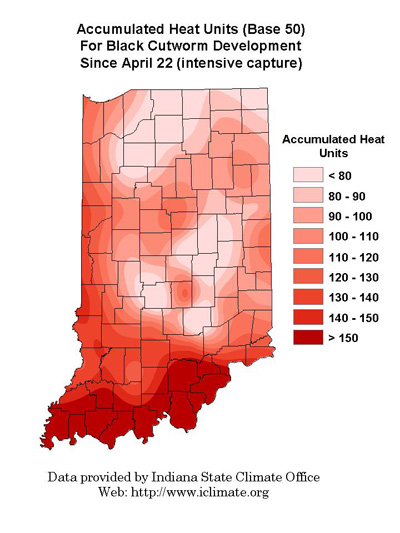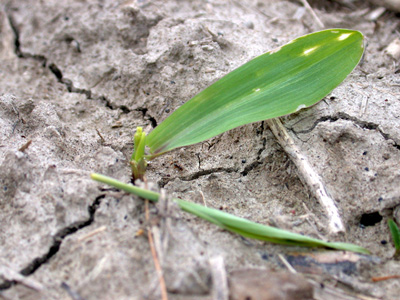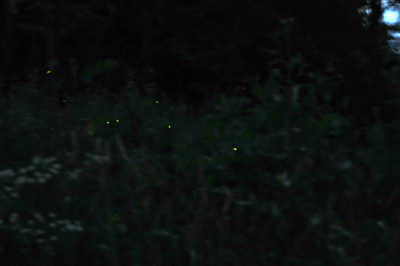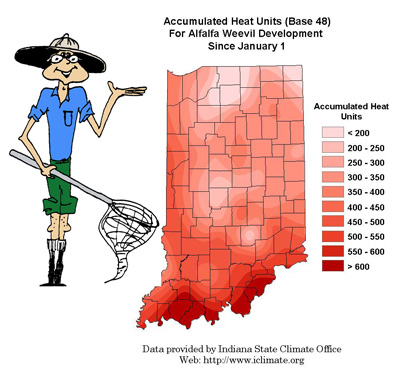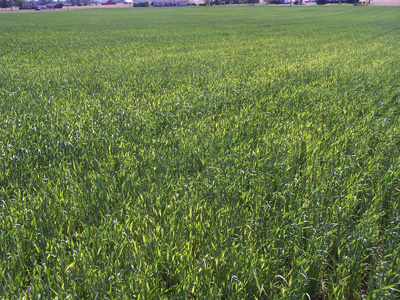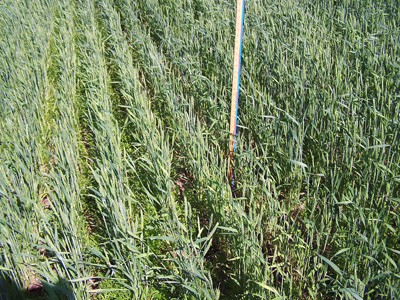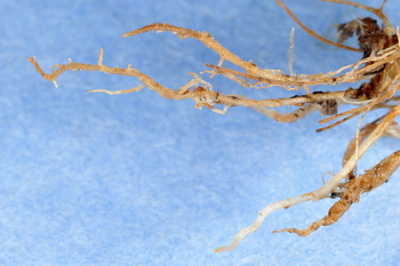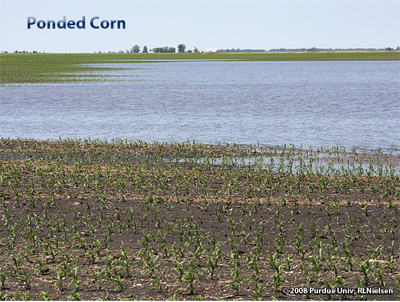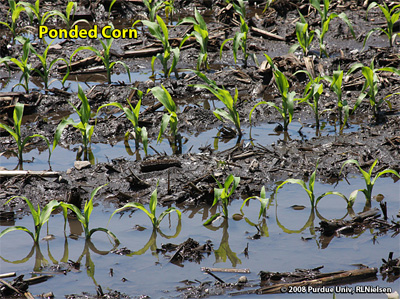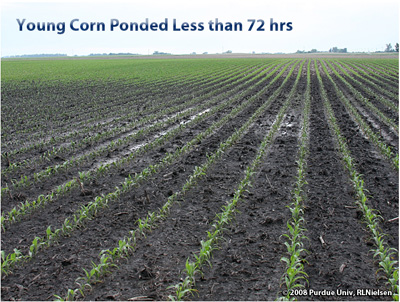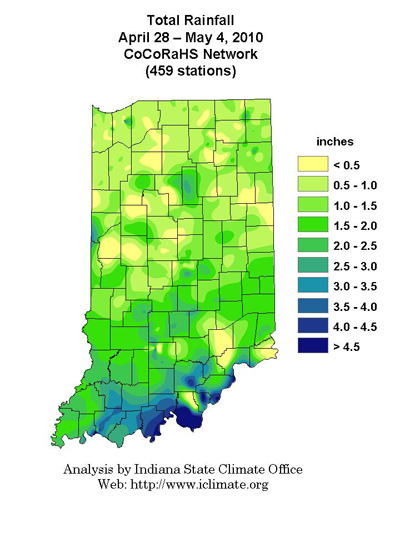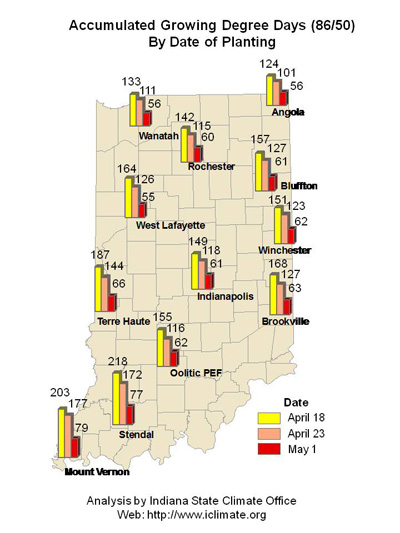Pest & Crop Newsletter, Entomology Extension, Purdue University
- Black Cutworm Arrival and Development
- Corn Rootworm Development: Fireflies and Bt Corn
- Dupont/Pioneer's Refuge in the Bag (OAM1) Approved
- Nematode Update: Needle Nematodes on Wheat
- Black Light Trap Catch Report
- Black Cutworm Adult Pheromone Trap Report
- Soybean Seeding Rates to Achieve Target Stands at Harvest
- Effects of Flooding or Ponding on Young Corn
Black Cutworm Arrival and Development - (Christian Krupke and John Obermeyer)
- Black cutworm moths continue to arrive.
- Fields yet to be worked and planted are those of greatest risk to black cutworm damage.
- Seed/soil insecticides will provide suppression of this pest, NOT control of heavy populations.
Storm fronts over the last couple weeks have blown significant numbers of black cutworm moths into Indiana. The timing of intensive moth captures (9 or more moths caught over a 2-night period) and subsequent larval development may be a problem for corn yet to be planted.
Refer to the following map, where we are tracking black cutworm development from the time of an intensive capture to when we expect first cutting/damage. Based on the growth development model, it takes approximately 300 heat units (50?F base) from egg hatch to early 4th instar; this is the life stage when black cutworm larvae begin to cut plants. Some leaf injury may be present before then. Using pheromone trapping of moths and tracking of heat unit accumulations for first cutting is not an exact science, but they do give us a good indication of what to expect. It is not possible to predict if individual fields will be infested.
Accumulated Heat Units (Base 50) For Black Cutworm Development Since April 22 (intensive capture)
Fortunately, with this season’s record corn planting pace, most of this corn will be developed to the point of “out-growing” the black cutworm. Of those fields yet to be worked and planted, moths may have found these weedy fields as an ideal egg-laying site. Tillage at, or just before, planting will provide little control of the eggs or newly hatched larvae. Since black cutworm has been a minor pest the past years, producers may have a false sense of security with the seed-applied insecticides. Timely scouting and rescue foliar insecticides when necessary are the tried and true approach with this stand reducer. Happy scouting!
Symptom of initial cutting by black cutworm
Corn Rootworm Development: Fireflies and Bt Corn - (Christian Krupke and John Obermeyer)
- Extremely early for reported firefly flashes, perhaps indicating an earlier start to rootworm egg-hatch.
- Rootworm eggs hatch over an extended period of time, with a recent trend toward later hatch.
- Bt-RW corn may be causing this shift towards later rootworm development.
Some astute observers have noticed and reported fireflies flashing over the past weekend, which normally signals that rootworm egg hatch is beginning. This phenological indicator has been recognized for decades and has been rather reliable. But because this normally doesn’t happen for another three weeks, we were dubious and considered it an anomaly. Then Steve Mrockiewicz of Syngenta Crop Protection in WC Indiana, called and confirmed the sightings. Steve’s thesis in the early 90’s, under the advisement of Tom Turpin, confirmed that the timing of emergence of a adult fireflies in the genus Photuris (large, common fireflies with greenish flashes) coincides with western corn rootworm egg-hatch. Is it possible for rootworm eggs to begin hatching three weeks early…maybe.
In recent years, this “start date” for rootworm development hasn’t varied much. However, we’ve also noticed that rootworm egg hatch, larval feeding and adult emergence have changed patterns in recent years. Although we don’t have the hard data to support it yet, researchers from throughout the Midwest are noting rootworm larvae feeding later into the season and the adult emergence is similarly spread out, even into September. There are many possible causes for this, but the widespread planting of Bt corn may be a possibility. There are two potential mechanisms here: the Bt corn is more toxic to rootworm earlier in its development and any larvae that survive have a longer development time to adulthood. Both of these favor later populations, both through eggs that hatch later having a greater chance of survival, and through the slowdown in development caused by feeding on a Bt plant.
What does this shift in rootworm development mean? Probably little at this time, but it’s interesting to note – especially if you dig roots looking for rootworm activity and feeding. We have been doing our root digs to look for rootworm damage later and later, and the former date of mid-July is now moving more toward mid-August. Years down the road however, we may have to rewrite the “book” on western corn rootworm development. For the time being, keep your eyes peeled for significantly more firefly flashes in the next couple weeks…they’re trying to warn us!
Firefly activity in the next weeks should signal the beginning of rootworm egg hatch
![]()
Dupont/Pioneer’s Refuge in the Bag (OAM1) Approved– (Christian Krupke and John Obermeyer)
Many have been following the submission by Dupont/Pioneer to the EPA to shift from the current 80/20 structured refuge, towards a blended refuge – this is also called “seed mixing” or “refuge-in-a-bag” and offers the obvious advantages of convenience (just load up and plant all acreage) and 100% compliance with the chosen percentage follows. The request was 2-fold: 1) allowing incorporation of refuge in with Bt seed in the same bag and 2) reducing the refuge percentage from 20% to 5%.
EPA allowed for the mixing of seed, but specified a 10% refuge level. The registration is time-limited and expires in September 2010. Still, this represents a big step in the evolution of Bt corn/refuge systems and is probably not the last we’ll see of seed mix approaches to refuge management.
![]()
Bug Scout Says "All of Indiana needs to inspect alfalfa for weevil."
![]()
Nematode Update: Needle Nematodes on Wheat - (Jamal Faghihi, Christian Krupke and Virginia Ferris)
- Wheat is confirmed as host, and as being severely damaged by needle nematode.
- Poorly growing wheat in sandy soils, where corn has previously struggled, should possibly be tested for needle nematodes.
- Sampling procedures and contact information given below.
We always suspected that wheat was a good host for the needle nematode and warned last year to be on the lookout for this nematode on wheat. However, we have never isolated needle nematode from wheat roots before. Last week a sample from Jackson County was sent by Mr. Rick Scranton, Pioneer Hi-Bred, and from this sample we were able to isolate several juveniles of needle nematodes. He is reporting patches of stunted and abnormal looking wheat. He also indicated that the grower previously had similar issues on corn. The root symptoms are similar to those on corn, but because of delicate nature of wheat roots, the symptoms are not very obvious. The tips of the roots are truncated and resemble herbicide injury. Like corn, the above ground symptoms do not follow a regular pattern and are usually in patches.
Needle nematode damaged area of wheat field (Photo Credit: Rick Scranton)
Severely damaged area of field (Photo Credit: Rick Scranton)
We might speculate that needle nematodes start their invasion of wheat roots in the fall. Early in the following spring, when soil temperature rises to above 50ºF, needle nematodes can further invade the established wheat roots. The tiny nematodes aggregate around the roots and with the aid of hollow needle-type mouth parts suck the juice out of the wheat roots. Needle nematode activity usually starts when soil temperatures reach 50ºF and usually ceases when soil temperatures rise above 85ºF. If you have noticed patches of stunted wheat in sandy soil and previously had similar issues on corn, needle nematode might be the problem. In this case, you may wish to send the entire root system with adjacent soil to the Nematology Laboratory (address below) at Purdue University for analysis, to rule out the nematodes. Samples must be kept cool and prevented from drying. This is the perfect time to sample for needle nematodes.
The sampling procedures for most nematodes are similar. However, samples for the needle nematode must be taken before soil temperatures become too hot, in corn this is usually within 6 weeks after planting. Soil samples must be taken from a depth of 4-6 inches, as close as possible to the infected plants. It is essential to enclose the entire root system with soil surrounding the infected plants. A more detailed sampling procedure can be found on the following website: <http://www.entm.purdue.edu/nematology/samples.html>.
If you have any questions about corn nematodes or any other plant parasitic nematodes, you can contact Jamal Faghihi at 765-494-5901 or send an email to <jamal@purdue.edu>. Soil samples for nematode analysis can be sent to: Nematology laboratory, Purdue University, Department of Entomology, Smith Hall, 901 W. State Street, West Lafayette, IN 47907-2089. The cost for nematode analysis for each sample remains at $10/sample.
Close-up of needle nematode damaged wheat roots
![]()
Click here to view the Black Cutworm Adult Pheromone Trap Report
Click here to view the Black Light Trap Catch Trap Report
More on Fusarium Head Blight in Indiana Wheat – (Kiersten Wise)
Wheat in southern Indiana is heading out and beginning to flower. The recent rainy weather may have caused concern about development of Fusarium head blight, or scab, but the majority of the state is still at low to medium risk for Fusarium head blight according to the wheat scab risk model that was discussed in last week’s Pest and Crop article: <http://extension.entm.purdue.edu/pestcrop/2010/issue5/index.html#fusarium>. This risk assessment tool can be accessed through <http://www.wheatscab.psu.edu/>.
There is a slight chance of rain later in the week in southern IN, followed by cool, sunny weather. The periods of sunny and dry weather after rainfall are not favorable for infection by the fungus that causes Fusarium head blight. This fungus, Fusarium graminearium, infects wheat during flowering, beginning at Feekes 10.5.1, and prefers rainy, warm, and humid weather conditions for infection and disease development.
Producers in areas of medium risk that are wary of model predictions and have Fusarium head blight-susceptible varieties planted may choose to apply a fungicide. Fungicide applications need to be made at Feekes 10.5.1, or early flowering. There are several fungicides available for Fusarium head blight control, and these are listed in the foliar fungicide efficacy table developed by the North Central Regional Committee on Management of Small Grain Diseases or NCERA-184 committee: <http://www.ppdl.purdue.edu/ppdl/wise/NCERA_184_Wheat_fungicide_chart_2010_v2.pdf>.
Caramba, Prosaro, and Proline were given a rating of “good” based on a designation system from the Regional Wheat Disease Committee. Products containing only tebuconazole (Folicur, others) were rated as fair, and propiconazole alone (Tilt, others) was rated as poor for management of Fusarium head blight. Remember, fungicides that have a strobilurin mode of action are not labeled for Fusarium head blight suppression. Be sure to follow label restrictions on how many days must pass between fungicide application and harvest.
Low levels of foliar diseases such as Septoria/Stagonospora leaf blotch have been observed in some fields, but overall, foliar disease levels are low. We will need to continue to monitor the level of risk for Fusarium head blight development in wheat in central and northern Indiana as the crop approaches heading in these areas.
Soybean Seeding Rates to Achieve Target Stands at Harvest – (Shaun Casteel)
Midwestern soybean population studies have demonstrated that yield is maximized with uniform, harvest stands near 100 thousand plants per acre regardless of row width. Traditional recommendations were to seed around 130, 160, and 200 thousand seeds per acre for 30-in, 15-in, and 7.5-in soybean rows, respectively. However, I like to start at 130 to 150 thousand seeds per acre regardless of row widths then increase or decrease based (1) seed quality, (2) planting equipment and (3) field conditions.
1. Seed Quality
Seed purity is usually a given in commercially purchased seed, so the focus on quality will be centered on viability. A measure of viability is the standard warm germination test, which is the percent of the seed that germinates and develops into normal seedlings under “ideal conditions” (plenty of moisture and seven days at 77°F). If a seed lot was rated at 90% germination, the maximum plant population potential would be 117 to 135 thousand plants per acre when seeded at 130 to 150 thousand seeds per acre. Cool germination and accelerated aging tests can be performed as a better indicator of the seed response to planting in cooler soils.
2. Planting Equipment
Ideal conditions begin with good seed-to-soil contact, which is a factor of the planting equipment and the field. Planting equipment varies in performance in seed placement vertically (seed depth) and horizontally (seed spacing down the row). Seed depth can be a story of too shallow (sometimes even on the soil surface), too deep, and just right depending on the equipment. In many cases, these three depths all occur with one piece of equipment across one field and thus, seeding rates should be increased ~10 to 20% from our base. A more uniform seed placement is better than clumps of seed here and there, especially as seeding rates are lowered. Nearly 70% of soybean acres in Indiana are no-till, and thus, setting the coulters, row cleaners, and any other equipment is critical to prevent “hairpinning” (placing soybeans in a slot that is lined with crop residue rather than soil) and to avoid increasing seed rates. Planters tend to have good seed placement; whereas, drills tend to be variable and will require an increase in seeding rates.
3. Field Conditions
Previous crop residue and weed density play a role in seed-to-soil contact as previously mentioned. Soil temperatures are often a few degrees cooler in our fields of no-till than conventional tillage especially early in the planting season. Seeding rates are often higher in our early plantings due to the cool and wet soils, since soybean germination is slow and disease infection can be higher. Fungicide seed treatments are normally a good fit for planting in cool, wet soils (see a recent article from Carl Bradley for more information on fungicide seed treatments, <http://ipm.illinois.edu/bulletin/article.php?id=1274>).
Soils and fields of Indiana vary from sands to organic mucks, from prairie flats to clay knolls, from river bottoms to rolling hills, and some combinations even occur in the same field. Seeding rates to establish the same target plant stand could potentially be different based on these inherent factors. However, we currently do not have enough data to provide such recommendations. We are conducting on-farm seeding rate trials to fine tune recommendations across various planting conditions, regions, and soils. If you are interested in participating in the research, please visit the following Web site for more details <http://www.agry.purdue.edu/ext/ofr/>.
Plant populations of approximately 100 to 120 thousand plants per acre at harvest provide a savings in seed costs without sacrificing yield (Figure 1). Seeding rates to achieve this harvest stand vary depending on seed quality, planting equipment, and field conditions as well as other emergence factors. In a few cases, increasing the plant populations above 120 thousand plants per acre may slightly increase profitability provided the market price is high enough to absorb the increased seeding rate costs (see a recent article by Vince Davis for some economic seeding rate scenarios, <http://ipm.illinois.edu/bulletin/article.php?id=1296>.
Frost crystals on a corn leaf at sunup
![]()
Effects of Flooding or Ponding on Young Corn – (Bob Nielsen)
Recent intense rainfall events (technically referred to as “toad stranglers” or “goose drownders”) have caused flooding of low-lying corn fields or ponding in poorly drained swales within fields. Other areas within fields, while not technically flooded or ponded, may remain saturated for lengthy periods of time. What are the prospects for recently submerged corn fields?
The sarcastic answer is that flooded crops will survive until they die. What this statement means is that no one can tell you with certainty the day after the storm whether a ponded area of a corn field will survive or whether there will be long-term yield consequences until enough time has gone by such that you can assess the actual recovery of the damaged plants. We can, however, talk about the factors that increase or decrease the risks of severe damage or death to flooded soils.
Ponded corn
Ponded corn
Young corn ponded less than 72 hrs
- Corn that is completely submerged is at higher risk than corn that is partially submerged.
° Plants that are only partially submerged may continue to photosynthesize, albeit at limited rates.
- The longer an area remains ponded, the higher the risk of plant death.
°Most agronomists believe that young corn can survive up to about 4 days of outright ponding if temperatures are relatively cool (mid-60’s°F or cooler); fewer days if temperatures are warm (mid-70’s°F or warmer).
°Soil oxygen is depleted within about 48 hours of soil saturation. Without oxygen, the plants cannot perform critical life sustaining functions; e.g., nutrient and water uptake is impaired and root growth is inhibited.
- Even if surface water subsides quickly, the likelihood of dense surface crusts forming as the soil dries increases the risk of emergence failure for recently planted crops.
° Be prepared with a rotary hoe to break up the crust and aid emergence.
- The greater the deposition of mud on plants as the water subsides, the greater the stress on the plants due to reduced photosynthesis.
° Ironically, such situations would benefit from another rainfall event to wash the mud deposits from the leaves.
- Corn younger than about V6 (six fully exposed leaf collars) is more susceptible to ponding damage than is corn older than V6.
° This is partly because young plants are more easily submerged than older taller plants and partly because the corn plant’s growing point remains below ground until about V6. The health of the growing point can be assessed initially by splitting stalks and visually examining the lower portion of the stem (Nielsen, 2008b). Within 3 to 5 days after water drains from the ponded area, look for the appearance of fresh leaves from the whorls of the plants.
- Extended periods of saturated soils AFTER the surface water subsides will take their toll on the overall vigor of the crop.
° Some root death will occur and new root growth will be stunted until the soil dries to acceptable moisture contents. As a result, plants may be subject to greater injury during a subsequently dry summer due to their restricted root systems.
- Concomitant (I found a new word in the dictionary!) with the direct stress of saturated soils on a corn crop, flooding and ponding can cause significant losses of soil nitrogen due to denitrification and leaching of nitrate N.
° Significant loss of soil N will cause nitrogen deficiencies and possible additional yield loss.
°On the other hand, if the corn dies in the ponded areas it probably does not matter how much nitrogen you’ve lost.
- Lengthy periods of wet soil conditions favor the development of seedling blight diseases, especially those caused by Pythium fungi (Sweets, 2008). Poorly drained areas of fields are most at risk for the development of these diseases and so will also be risky for potential replant operations.
- Certain diseases, such as common smut and crazy top, may also become greater risks due to flooding and cool temperatures (Malvick, 2002).
° The fungus that causes crazy top depends on saturated soil conditions to infect corn seedlings.
°The common smut fungal organism is ubiquitous in soils and can infect young corn plants through tissue damaged by floodwaters. There is limited hybrid resistance to either of these two diseases and predicting damage is difficult until later in the growing season.
Related References
Elmore, Roger and Lori Abendroth. 2008. Flooded Corn and Saturated Soils. Integrated Crop Management Newsletter, Iowa State Univ Extension. [On-line]. Available at <http:// www.extension.iastate.edu/CropNews/2008/0530RogerElmoreLori+Abendroth.htm> [URL accessed May 2010].
Farnham, Dale. 1999. Corn survival in wet conditions. Iowa State Univ. Integrated Crop Management Newsletter. [On-line] Available at <http:// www.ent.iastate.edu/ipm/icm/1999/5-24-1999/wetcorn.html> [URL accessed May 2010].
Malvick, Dean. 2002. Crazy Top in Corn. The Bulletin, Univ of Illinois Extension. [On-line]. Available at <http:/www.ipm.uiuc.edu/bulletin/pastpest/articles/200220c.html> [URL accessed May 2010].
Nielsen, RL (Bob). 2008a. Determining Corn Leaf Stages. Corny News Network, Purdue Univ. [On-Line]. Available at <http://www.kingcorn.org/news/timeless/VStageMethods.html> [URL accessed May 2010].
Nielsen, RL (Bob). 2008b. Growing Points of Interest. Corny News Network, Purdue Univ. [On-Line]. Available at <http://kingcorn.org/news/timeless/GrowingPoints.html> [URL accessed May 2010].
Nielsen, RL (Bob). 2008c. Tips for Staging Corn with Severe Leaf Damage. Corny News Network, Purdue Univ. [On-Line]. Available at <http://www.kingcorn.news.timeless/VStagingTips.html> [URL accessed May 2010].
Nielsen, RL (Bob). 2008d. Use Thermal Time to Predict Leaf Stage Development in Corn. Corny News Network, Purdue Univ. [On-Line]. Available at <http://www.kingcorn.news.timeless/VStagePrediction.html> [URL accessed May 2010].
Owen, Mike. 2008a. Replant Options in Corn Fields. Integrated Crop Management Newsletter, Iowa State Univ Extension. [On-line]. Available at <http://www.extension.iastate.edu/CropNews/2008/0531MikeOwen2.htm> [URL accessed May 2010].
Owen, Mike. 2008b. Replanting Corn – How Do You Get Rid of the Existing Stand? Integrated Crop Management Newsletter, Iowa State Univ Extension. [On-line]. Available at <http://www.extension.iastate.edu/CropNews/2008/0531MikeOwen.htm> [URL accessed May 2010].
Sweets, Laura. 2008. Seed Decay and Seedling Blights of Corn. Integrated Pest & Crop Management Newsletter, Univ of Missouri Extension. [On-line]. Available at <http:// ppp.missouri.edu/newsletters/ipcm/archives/fullissue/v18n9.pdf> [URL accessed May 2010].
Thomison, Peter. 2006. Ponding Effects on Corn. C.O.R.N. Newsletter, Ohio State Extension. [On-line]. Available at <http://corn.osu.edu/story.php?setissueID=134&storyID=783> [URL accessed May 2010].

